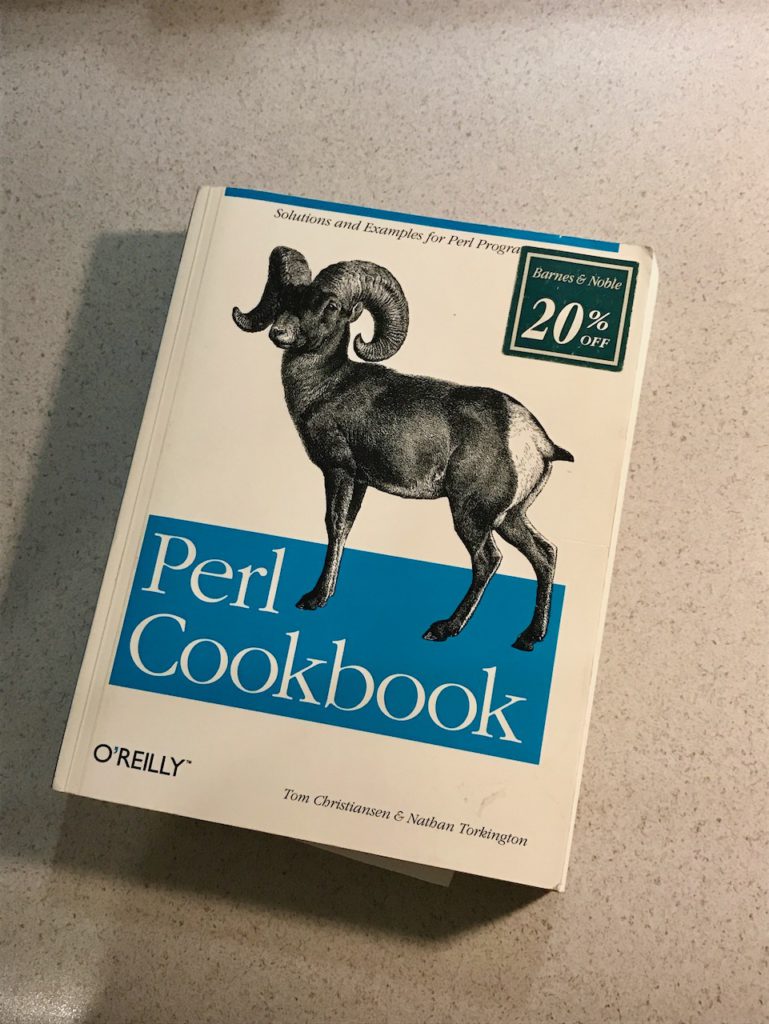Introduction
What makes a great—essential—cookbook for the kitchen? For some, a reliable no nonsense style is ideal, while others enjoy a pinch of history alongside the steps and ingredients. Physical cookbooks enjoy strong sales. Whether the volumes on your shelf are inherited or have been curated from your culinary life goals, a good recipe can make the difference between a delicious meal or a pile of uneaten disappointment.
First published in 1998, the Perl Cookbook became an essential part of my professional library. Written by Tom Christiansen and Nathan Torkington, and published by O’Reilly Media, the book contains many recipes written in the Perl computer language tied to a specific problem or goal. Various resources available via the Internet make it fairly easy to find examples of how to perform various tasks via different programming languages, but in 1998 it was a bit more difficult.

Currently available resources aside, the Perl Cookbook is as valuable today as it was when first published since the structure is clean and straightforward, and the range of solutions provides a wealth of Perl programming knowledge. Why wade through a big box store when you can get what you need from a well curated shop?
The Animals of O’Reilly Books
O’Reilly books sport distinctive covers featuring a variety of animals, one per topic. I’ve always thought the animal covers implied a sense of humor and creativity for technical topics that can be rather dry. The O’Reilly books I’m familiar with are written in such a way that they are enjoyable to read because of the focus of mastering a skill. O’Reilly titles have always been a joy for me, written in such a way that you can either get at specific information or provide a feeling of accomplishment if you devote some time and energy to a title. I miss walking into a physical bookstore and seeing rows and rows of computer books, promising to help me master everything from Cascading Style Sheets to Java. Alas, I’ve always been a bit better at buying books than reading them.
Here’s the list of O’Reilly animals: https://www.oreilly.com/animals.csp
Status: Revered Previous Resident
Revisiting the idea of cookbooks in the kitchen, the choices on the shelf often evolve not out of preference, but out of necessity. My wife is an avid runner, and I’m thinking more each year about how to keep my blood flowing freely, and so we own more cookbooks focused on heart healthy meals than we did a decade ago.
The Perl Cookbook has been an occupant of The Room of Many Things (TROMT) for many years. It vacationed in my various office and cubicle workspaces for years. I recently cleaned out my office space in anticipation of working at home for the foreseeable future (keep in mind I’m writing this post in 2020). As I lifted the Perl Cookbook and noted its heft, a thought occurred to me: I don’t write code in Perl anymore, and my edition is decently out of date. As I held the published tomb that helped me to at least act as if I was a Perl developer for a number of years, I stared at the boxes already filled with precious items. I thumbed through the book, paying particular attention to the sections addressing String, Arrays and Hashes, and CGI Programming. Oh and Pattern Matching — so much time spent just looking for patterns or excluding them.
And with that, I decided my Perl Cookbook would have to live forever in my memories. Thank you Tom Christiansen and Nathan Torkington for writing such a wonderful companion.